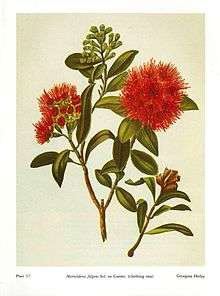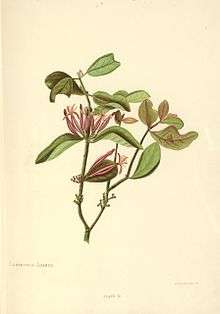Georgina Hetley
Georgina Burne Hetley (née McKellar, 27 May 1832 – 29 August 1898) was a New Zealand artist and writer. Her book The Native Flora of New Zealand was published in English and French. She was born in Battersea, Surrey, England on 27 May 1832.[1][2]

Early life
Hetley was the second daughter of Annette and Dugald McKellar, a doctor. The family moved to Madeira, Portugal when Hetley was around 10 years old, leaving in 1852 for New Zealand when her father died. Annette McKellar bought a block of about fifty acres of land at Omata, six miles south of New Plymouth. She called their farm Fernlea. Hetley subsequently married a fellow settler Charles Hetly in the Omata church on 2 June 1856 and moved to Brookwood farm. Just prior to their first wedding anniversary Charles died, leaving Hetly with a newborn son.[1][3] This led to Hetley selling her farm and returning to Fernlea to live with her mother.
Hetley lived in Taranaki until 1860 when the First Taranaki War broke out. The conflict led to Anette McKellar moving her family to New Plymouth. Fernlea was burnt down in the ensuing conflict. While in Taranaki, Hetley began drawing sketches and watercolours of the farm and surrounding landscapes. She continued this practice after the move to New Plymouth, painting the urban scenes in New Plymouth, Waikato and Auckland. She and her son moved to Auckland by 1879.[1]
Exhibitions and publications
In 1879, Hetley exhibited with the Auckland Society of Artists. In 1885 she won first prize at the New Zealand Industrial Exhibition in Wellington for her paintings of indigenous plants. Following a lecture about a botanical trip to Nelson given by Thomas Frederic Cheeseman at the Auckland Museum in 1881,—and with considerable encouragement from him—Hetley was inspired to write a comprehensive guide to New Zealand flora. This would be following in the style of Dr Walter Buller's book on New Zealand birds that had been published in 1873. By 1884, she had started work on a book of native plants, The Native Flowers of New Zealand Illustrated in Colours, embarking (with the backing from the government and the Union Steamship Company) on a trip around New Zealand to obtain live specimens. She collected plants from the North Island and travelled to the South Island to collect specimens from Nelson, Greymouth and Arthurs Pass. She spent six weeks in Christchurch, sketching the plants in their botanical gardens which came from places she was unable to travel to. This included Stewart Island and the Chatham Islands.[4]

Hetley went to England to seek a publisher, receiving assistance along the way from authorities at Kew, and the chromolithographs were ultimately produced in 1888 by Leighton Brothers. The plates also had the distinction of being published in a French edition a year later.[4] The inclusion in the book of Loranthus adamsii is notable as this native mistletoe was discovered by Mr James Adams of the Thames goldfields shortly before it became extinct. Without the work of botanical artists such as Hetley there would be no record of what this plant truly looked like.[3] While in London, her work was exhibited at the Colonial and Indian Exhibition.
Hetley returned to New Zealand in 1889 and exhibited her New Zealand flora at the General Assembly Library in Wellington. She also help another major exhibit, 150 paintings in all, at Auckland Museum. Hetley lived in Auckland for the rest of her life, dying there after a long illness, on 29 August 1898.[3]
References
| Wikimedia Commons has media related to Georgina Hetley. |
- Starke, June. "Georgina Burne Hetley". Dictionary of New Zealand Biography. Ministry for Culture and Heritage. Retrieved 5 February 2012.
- Taonga, New Zealand Ministry for Culture and Heritage Te Manatu. "Hetley, Georgina Burne". Retrieved 5 October 2018.
- Dawson, Bee (1999). Lady painters : the flower painters of early New Zealand. Auckland, N.Z.: Viking. pp. 77–91. ISBN 0670886513.
- Eagle, Audrey (2013). The essential Audrey Eagle. Introduction by Dr Patrick Brownsey. Wellington, New Zealand: Te Papa Press. Introduction pages 14 - 15. ISBN 9781877385902.
| Wikisource has original text related to this article: |